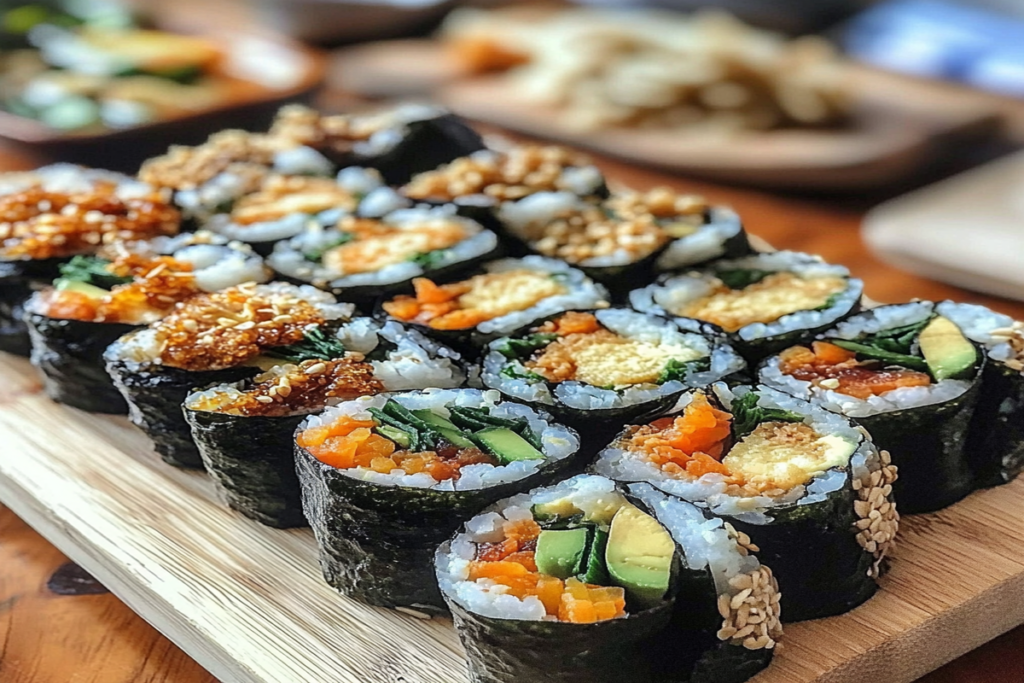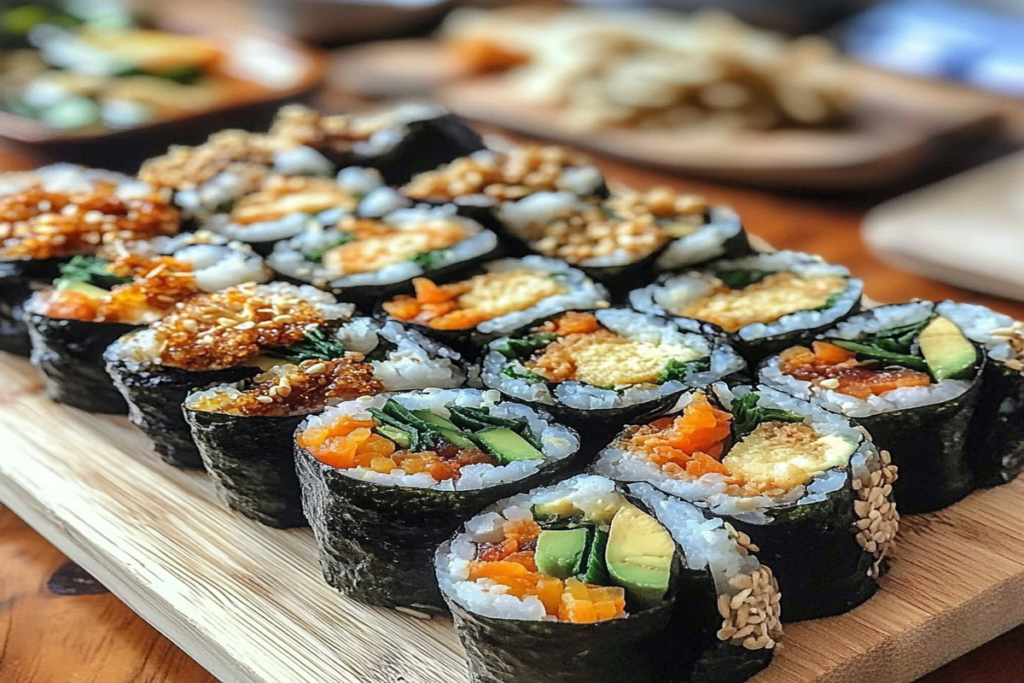Kimbap, also known as gimbap, is a beloved Korean dish that has become increasingly popular worldwide. But as its popularity grows, so does the debate: Which is the correct term, kimbap or gimbap? This question may seem trivial to some, but it touches on important aspects of language, culture, and identity.
Introduction: The Kimbap vs. Gimbap Debate
Many people wonder whether “kimbap” or “gimbap” is the correct term. Both terms refer to the same dish—a delicious rice roll wrapped in seaweed and filled with various ingredients like vegetables, meat, or fish. But why do two different spellings exist?
Understanding this requires a look at Korean romanization, which is the process of converting Korean script (Hangul) into the Latin alphabet. The debate over “kimbap” versus “gimbap” stems from this process, where certain Korean sounds can be represented in multiple ways in English. According to the Korean Cultural Center, this is a common issue in the romanization of Korean words, leading to multiple acceptable spellings.
Linguistic Explanation: Why Both “Kimbap” and “Gimbap” Are Correct
The Korean Alphabet and Romanization
Korean uses Hangul, a unique script created in the 15th century. In Hangul, “김밥” is the word for this dish. The first character “김” is pronounced with a sound that falls between “k” and “g” in English, while the second character “밥” is pronounced with a “b” or “p” sound, depending on context.
When Korean words are transliterated into the Latin alphabet, the sounds of the Korean letters can be represented in more than one way. This is where the confusion between “kimbap” and “gimbap” arises. The Revised Romanization of Korean, the official system used by the South Korean government, generally favors “g” over “k” when romanizing the initial sound of “김”.
The Interchangeability of “K” and “G”
In Korean, the consonant ㄱ (giyeok) can be pronounced as either “k” or “g” depending on its position in a word and the surrounding vowels. At the beginning of a word, it often sounds closer to “g”, but in many contexts, it can also sound like “k”.
Cultural Significance of Kimbap/Gimbap
Kimbap/Gimbap as a Staple in Korean Cuisine
Kimbap, or gimbap, is more than just a tasty dish—it’s a cultural icon in Korea. The name “kimbap” literally translates to “seaweed rice,” highlighting the two main ingredients. Its versatility and ease of preparation have made it a staple in Korean households for generations.
Culturally, kimbap/gimbap reflects the Korean emphasis on communal dining and the importance of family meals.
How Naming Conventions Reflect Cultural Elements
The debate over whether to use “kimbap” or “gimbap” also reflects broader cultural elements within Korea. The flexibility in romanization mirrors the adaptability and resilience of Korean culture, which has maintained its traditions while also embracing modernization and global influences. The choice of spelling can also reflect regional preferences or personal identity, with some individuals feeling more connected to one version over the other.
In international contexts, “kimbap” might be more commonly seen due to the influence of early romanization systems that favored the “k” sound.
Common Usage in Korea: Do Koreans Prefer “Kimbap” or “Gimbap”?
Regional Preferences and Trends
In Korea, both “kimbap” and “gimbap” are widely recognized and accepted. However, the preference for one term over the other can vary depending on the region and context. This aligns with the Revised Romanization system, which promotes “gimbap” as the correct spelling.
Conversely, in casual conversation, many Koreans still refer to the dish as “kimbap”. This may be due to historical usage, personal habit, or the fact that “kimbap” was the more common romanization in the past.
Influence of Regional Dialects
Korean dialects, known as “saturi”, also play a role in the pronunciation and, consequently, the romanization of words. In other regions, it might sound closer to a “g”, hence “gimbap”.
International Recognition: How Is “Kimbap” or “Gimbap” Used Globally?
Kimbap/Gimbap in International Restaurants and Media
The spelling used often depends on the restaurant’s location, the target audience, and the owner’s preference.
This shift aligns with the growing trend of using more accurate romanization in line with the official guidelines.
The Role of Korean Pop Culture in Spreading the Terms
Korean pop culture, including K-dramas, K-pop, and movies, has played a significant role in introducing kimbap/gimbap to a global audience.
The influence of Hallyu has also led to the adoption of Korean terms in their more “authentic” forms, meaning that “gimbap” is increasingly recognized as the correct spelling by non-Korean speakers. However, due to the legacy of older romanization systems and the widespread use of “kimbap” in English-speaking countries, both terms continue to coexist on the global stage (The Impact of Hallyu on Global Cuisine).
Impact of Globalization on the Kimbap/Gimbap Debate
Globalization and Language Evolution
Globalization has significantly influenced the evolution of language. The spread of Korean culture worldwide has led to increased exposure to Korean terms, with varying interpretations of how they should be romanized. As Korean food becomes more mainstream, the debate over “kimbap” versus “gimbap” reflects broader questions about language standardization and cultural preservation.
In countries where Korean is not widely spoken, the choice between “kimbap” and “gimbap” can influence how people perceive and connect with the dish.
The Role of the Internet and Social Media
The internet and social media have accelerated the spread of both “kimbap” and “gimbap” across the globe. On platforms like Instagram, YouTube, and TikTok, users from different countries showcase their versions of kimbap/gimbap, often using the spelling they are most familiar with. This has led to a mix of both terms appearing in hashtags, captions, and video titles, further fueling the debate.
Social media influencers and content creators also play a significant role in shaping public perception of which term is “correct”.
The Debate Over Romanization: “Kimbap” vs. “Gimbap”

Examination of Official Romanization Systems
The South Korean government officially adopted the Revised Romanization system in 2000, replacing the older McCune-Reischauer system. Under this system, “gimbap” is the recommended spelling, as it more closely aligns with the original Korean pronunciation of “김밥”.
Despite this, the McCune-Reischauer system and other older romanization methods are still in use, particularly outside of Korea. These systems often favored “k” over “g”, which is why “kimbap” became widely accepted in English-speaking countries.
Academic and Linguistic Arguments
Linguists and language scholars often argue in favor of the Revised Romanization system because it provides a more standardized approach to transliterating Korean words into English. However, the debate is not purely academic; it also touches on issues of cultural identity and language evolution.
In each case, the goal is to balance accuracy with accessibility, making the language understandable to a global audience while preserving its original character.
Perceptions and Preferences: Why Some Prefer “Kimbap” Over “Gimbap”
Analysis of Regional and Generational Preferences
As mentioned earlier, the preference for “kimbap” or “gimbap” can vary based on region, age, and personal experience. Older generations who grew up with the McCune-Reischauer system may be more accustomed to seeing and using “kimbap”.
Regional differences also play a role. These preferences highlight the dynamic nature of language and how it evolves within different social and cultural contexts.
The Impact of Marketing and Branding
The food industry, particularly in international markets, has a significant influence on the spelling of kimbap/gimbap. Restaurants, food brands, and marketers often choose the spelling that they believe will resonate best with their target audience.
Branding and marketing decisions also reflect broader trends in consumer preferences. As more people become interested in Korean culture and language, there may be a gradual shift towards using “gimbap” in line with the official romanization. However, “kimbap” is likely to remain in use due to its established presence in the market.

FAQs: Clarifying Common Questions About “Kimbap” vs. “Gimbap”
Why Are There Two Different Spellings for the Same Dish?
The existence of two different spellings—”kimbap” and “gimbap”—stems from the romanization of Korean words. The Korean consonant “ㄱ” can be romanized as either “k” or “g”, depending on the system used.
Is “Gimbap” the More Authentic Spelling?
“Gimbap” is considered more accurate according to the Revised Romanization system, which is the official romanization method in South Korea. This system aims to better reflect the pronunciation of Korean words in English.
Do Koreans Care About Which Term Is Used?
Most Koreans are familiar with both “kimbap” and “gimbap” and may use them interchangeably. While some might have a preference for one term over the other, the difference is generally not a major concern.
How Should I Spell It If I’m Writing a Menu or a Blog?
If you are writing for an international audience, it’s a good idea to consider your target readers. If they are more familiar with the term “kimbap”, you might choose to use that spelling. In any case, consistency in your usage is key.
What Are Other Examples of Similar Romanization Issues in Korean?
Romanization issues are common in Korean, especially with consonants like “ㄱ” (g/k), “ㄷ” (d/t), and “ㅂ” (b/p). For example, the Korean capital “서울” can be romanized as “Seoul” (using the Revised Romanization) or “Soul” (a less common alternative). These variations highlight the challenges of accurately representing Korean sounds in the Latin alphabet.
Conclusion: Which Is Correct, Kimbap or Gimbap?
In conclusion, both “kimbap” and “gimbap” are correct spellings for this popular Korean dish. While “gimbap” aligns with the official Revised Romanization system, “kimbap” remains widely accepted and recognized, especially in English-speaking countries.
Ultimately, the most important thing is to enjoy the dish itself, whether you call it “kimbap” or “gimbap”. Both spellings reflect the rich cultural heritage of Korea, and both are equally valid.

